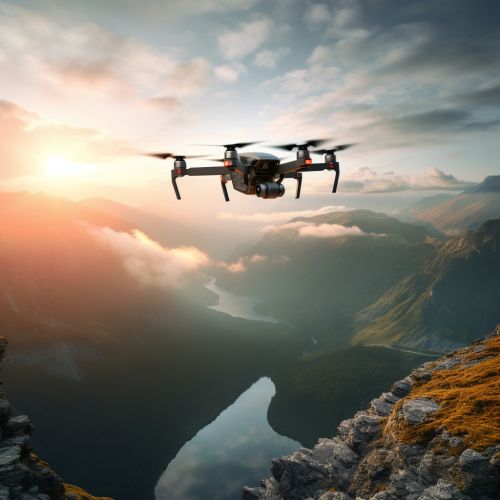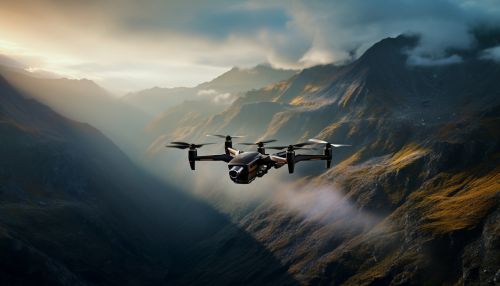The Role of Computer Vision in Autonomous Drone Flight
Introduction
Computer vision, a subfield of artificial intelligence (AI), plays a crucial role in the operation of autonomous drones. Autonomous drones, also known as unmanned aerial vehicles (UAVs), rely on computer vision to navigate, avoid obstacles, recognize objects, and perform other tasks without human intervention. This article explores the role of computer vision in autonomous drone flight, delving into the underlying principles, technologies, and applications.


Computer Vision and Its Role in Autonomous Drone Flight
Computer vision is a field of study that enables computers to interpret and understand the visual world. It involves the acquisition, processing, analysis, and understanding of digital images to produce numerical or symbolic information. In the context of autonomous drones, computer vision is used to perform tasks such as object detection, image recognition, and navigation.
Object Detection and Image Recognition
Object detection and image recognition are fundamental aspects of computer vision that are extensively utilized in autonomous drone flight. Object detection involves identifying specific objects within digital images or video streams, while image recognition is the process of identifying and categorizing what is in an image.
Autonomous drones use object detection to identify potential obstacles in their flight path. For example, a drone might use computer vision to detect trees, buildings, or other drones to avoid collisions. Image recognition, on the other hand, can be used for tasks such as identifying specific landmarks for navigation or recognizing specific objects or persons for surveillance or delivery tasks.
Computer vision is also instrumental in the navigation and path planning of autonomous drones. Navigation involves determining the drone's position and orientation relative to its environment, while path planning involves determining the optimal route to a destination.
Autonomous drones use computer vision to construct a map of their environment, a process known as simultaneous localization and mapping (SLAM). This map is then used for navigation and path planning. For example, a drone might use computer vision to identify landmarks and use these landmarks to determine its position and orientation. It might also use computer vision to identify obstacles and plan a path that avoids these obstacles.
Technologies Underlying Computer Vision in Autonomous Drone Flight
Several technologies underpin the application of computer vision in autonomous drone flight, including sensors, algorithms, and machine learning techniques.
Sensors
Sensors are a critical component of computer vision systems in autonomous drones. These sensors capture visual data, which is then processed and analyzed by the computer vision system. Common types of sensors used in autonomous drones include cameras, LiDAR, and radar.
Cameras are the primary sensor used for computer vision in autonomous drones. They capture visual data in the form of digital images or video streams. LiDAR (Light Detection and Ranging) and radar sensors, on the other hand, are used to capture depth data, which is used to construct a 3D map of the drone's environment.
Algorithms
Algorithms are the backbone of computer vision systems, enabling them to process and analyze visual data. These algorithms range from basic image processing techniques to complex machine learning algorithms.
Basic image processing algorithms are used to preprocess the visual data, performing tasks such as noise reduction, contrast enhancement, and edge detection. Machine learning algorithms, on the other hand, are used to perform tasks such as object detection, image recognition, and SLAM.
Machine Learning Techniques
Machine learning techniques play a significant role in the application of computer vision in autonomous drone flight. These techniques enable the computer vision system to learn from experience, improving its performance over time.
Supervised learning techniques are commonly used for tasks such as object detection and image recognition. These techniques involve training a model on a labeled dataset, where the model learns to associate input data (e.g., images) with output data (e.g., object labels).
Unsupervised learning techniques, on the other hand, are commonly used for tasks such as SLAM. These techniques involve training a model on an unlabeled dataset, where the model learns to identify patterns in the data without any prior knowledge.
Applications of Computer Vision in Autonomous Drone Flight
The application of computer vision in autonomous drone flight spans various industries and use cases, including surveillance, delivery, agriculture, and disaster response.
Surveillance
In surveillance, autonomous drones use computer vision to monitor specific areas or track specific objects or persons. For example, a drone might use object detection to identify a specific vehicle or person and follow them. It might also use image recognition to identify specific activities or behaviors, such as a crowd gathering or a vehicle speeding.
Delivery
In delivery, autonomous drones use computer vision to navigate to a specific location and deliver a package. For example, a drone might use SLAM to construct a map of its environment and plan a path to the delivery location. It might also use object detection to identify the delivery location (e.g., a mailbox or a doorstep) and image recognition to confirm the delivery (e.g., by taking a picture of the delivered package).
Agriculture
In agriculture, autonomous drones use computer vision to monitor crops and detect signs of disease or pests. For example, a drone might use image recognition to identify specific types of crops or detect signs of disease or pests. It might also use object detection to identify specific areas of a field that need attention, such as areas with low soil moisture or high weed density.
Disaster Response
In disaster response, autonomous drones use computer vision to survey disaster areas and assist in rescue operations. For example, a drone might use SLAM to construct a map of a disaster area, providing rescuers with valuable information about the area. It might also use object detection and image recognition to identify survivors or hazards, assisting rescuers in their efforts.
Conclusion
Computer vision plays a critical role in the operation of autonomous drones, enabling them to perform tasks such as object detection, image recognition, navigation, and path planning. The application of computer vision in autonomous drone flight spans various industries and use cases, demonstrating the versatility and potential of this technology.
